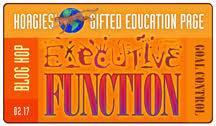Executive functions consist of those mental processes that allow us to participate fully in a variety of roles and relationships through planning, focusing and remembering while controlling our impulses and working systematically to achieve goals. There is an expectation that students arrive at school with a number of these skills already developed, enabling them to participate in a group learning environment. While children generally begin developing these skills at a very young age in their homes with their families, the development of these functions continues through adolescence.
The relationship between giftedness and executive functioning is an interesting one. Some studies have shown that math abilities correlate significantly with executive functioning with some variances. (Rebecca Bull and Gaia Scerif, 2010.) Other studies find a correlation between executive functioning and achievement. (St. Clair-Thompson and Gathercole, 2010.) In gifted education we know that cognitive abilities do not guarantee academic achievement and underachieving gifted students-could this be related to struggles with executive functions in some cases? In his work, Re-examining the Role of Gifted Education and Talent Development for the 21st Century, Joseph Renzulli speaks to the necessity of talent and cognitive development going hand in hand with what he calls the “character strengths” of executive functions. These are developed through addressing novel situations that require children to draw on and develop these skills for success. But what does this look like in practice?
A week ago I was working with three gifted 8 year olds on one of the Destination Imagination challenges. Designed to foster curiosity, courage and creativity, I use this program not only as a means to challenge my students to solve novel and complex problems, but to create scenarios where I can help them cultivate their virtues (gifts of character) as they learn project management skills and collaboration. They were trying to solve an instant challenge that involved building a tower within specific parameters when things fell apart. Two of the students took over the task while the third withdrew with tears streaming down his face. I quietly acknowledged that I saw his tears and sat with him while we waited for the other two students to complete the task.
After measuring the height of their structure we began debriefing the teamwork part of the challenge at which point they acknowledged that it had not gone well and that there had been some conflict. I spoke to them about conflict arising when there is a difference in the individual interests in carrying out a task and asked each of them what had been important to them as they were working on the challenge.
“To do it right,” the boy with tears responded.
“That would be the virtue of excellence,” I said, writing the word on the board.
“To work on it together,” responded the girl who had taken the structure away from the boy.
“That sounds like the cooperation virtue is important to you,” I said, writing it on the board beside excellence.
The third student responded that they were frustrated because the boy had not explained to them what he was doing before starting to build the solution.
“You needed understanding,” I said, writing that virtue on the board. “Now look at the things causing your conflict. They are all virtues. Are they important virtues to nurture on your team?” All three nodded. “So how can we get these virtues working together?” I asked.
After some discussion they agreed that communication was important and also came to understand that communicating with words was sometimes difficult for the boy. After we agreed that this was something we would work on together they were ready to move on. We had an incredibly productive morning and this new understanding continued the next time we met.
What really touched me about this incident was the ability of these children to see the virtues in each others actions despite the fact that they had really struggled. It empowered them to understand themselves and each other better as they moved forward to complete more tasks successfully.
“Children aren’t born with these skills[executive functions]—they are born with the potential to develop them.” -Centre on the Developing Child, Harvard University
This statement reflects the premise guiding the Virtues Project as well-that children are born in potential and as with anything that is “in potential”-seeds, executive functions, virtues, habits… require certain conditions to grow and develop. Those of us privileged to work with and parent children need to understand our role in creating those conditions and not give up when we don’t see in some children what may seem innate in others as it is an opportunity to play our part in their development.
“Providing the support that children need to build these skills at home, in early care and education programs, and in other settings they experience regularly is one of society’s most important responsibilities.” -Centre on the Developing Child, Harvard University
For more insight on this topic check out the overview video at the Centre on the Developing Child-Harvard University which does a brilliant job of explaining executive functioning and self regulation. The website itself highlights the relationship between working memory, mental flexibility and self-control and stresses the importance of children having opportunities to apply these skills in coordination with others. You can also learn more about executive functions at Hoagies Blog Hop by clicking here or on the icon below:





